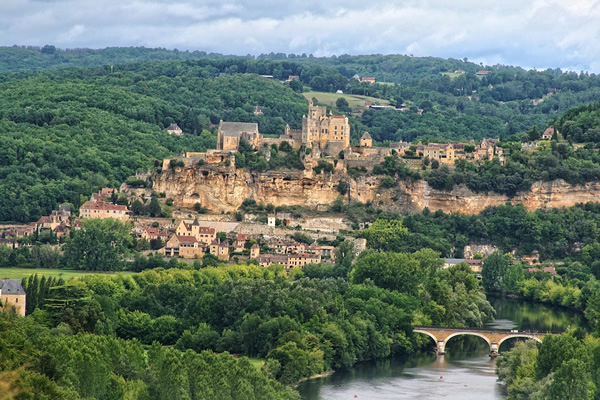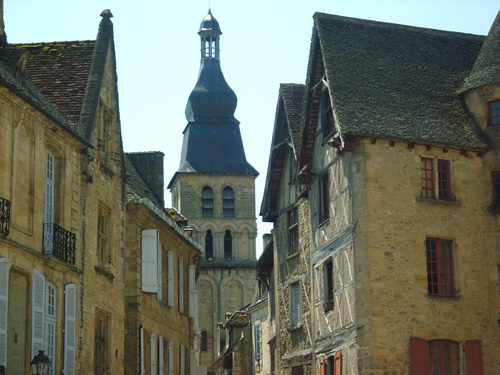|
The Cave Man Cometh
France's Dordogne River Valley
by Rick Steves

|
|
The town of Perigord, with a spectacular castle at its peak, in Dordogne, France.
|
Find your inner cave man on a trip to France's Dordogne River Valley. The attractions here are au naturale — a dreamy blend of rock-sculpted villages, fertile farms, photogenic vistas, gourmet cuisine, and relaxed canoe rides. The highlight: spine-tingling prehistoric cave art.
Set up camp in Sarlat (pop. 9,700), a pedestrian-filled banquet of a town amid the Dordogne's forested hills. It's a captivating tangle of traffic-free, golden cobblestone lanes peppered with beautiful buildings. Warmly lit at night, Sarlat is ideal for after-dinner strolls.
The town is small enough that everything is an easy walk from the town center, even for the fossils among us. Make a point to wander through Sarlat's main squares, and check out the Lantern of the Dead monument (dating from the 12th century, built to commemorate the end of a plague). You can pick up maps, brochures on regional sights, and information on canoe rentals at the tourist information office, near the Cathedral of St. Sacerdos on Place de Payrou. For a $3 fee, they can also reserve your hotel room or time slot for a prehistoric cave visit.

|
|
The old town of Sarlat in Dordogne.
|
Outdoor markets thrive in Sarlat on Wednesday mornings and all day Saturday, when the entire town is a splash of colorful stalls. The evolved hunter-gatherer will come away with a basket full of gourmet delicacies: gorgeous strawberries, Cabécou and Auvergne cheeses, wild mushrooms (truffles), confit de canard (hunks of duck smothered in white fat), and everything walnut — including walnut bread and walnut mustard.
The region's speciality is goose- or duck-liver pâté, or foie gras, which means "fattened liver." Geese and ducks are force-fed, denied exercise, and slaughtered for their enlarged liver. Foie gras tastes like butter and costs like gold (up to $22 for a solid tuna-can-sized chunk).
Force-feeding geese, a process called “la gavage,” is controversial, with animal rights' groups viewing the geese as tortured prisoners. But French enthusiasts say the birds are calm and the process is painless. They also say the birds' massive gullets and expandable liver (used to store lots of fat for their long migrations) are designed to take in food like this.
At nearby farms — signed “gavage” — you can see the process for yourself. One such farm is Elevage du Bouysson, a pastoral goose farm a short drive from Sarlat on D-704. Farmers Denis and Nathalie Mazat lead a 1-hour, kid-friendly tour each evening.
Peaceful Canoe Trips
Seeing the rest of the Dordogne region is a joy for drivers, but without a car you're like a caveman without a spear. Short taxi rides or minivan excursions can help fill the gaps. Trade in your spear for some oars on a peaceful canoe trip — by far the best way to see the Dordogne River Valley.
You can rent modern, light, and indestructible plastic canoes or kayaks for about $15 per person. Many rental places will pick you and your canoe up at an agreed-upon spot, making for a fun round-trip and a great family activity.
The town of Vitrac, on the river close to Sarlat, is a handy starting point. Beynac, with its impressive castle and pleasant hotels and restaurants, is a great place to end your journey. The 9-mile paddle will take you about two hours. All along the way, expect friendly waves from the locals, whose riverside picnics are actually elaborate campouts, complete with portable gazebos, tables, and chairs.
You'll paddle through lush, forested land past the fortified hill town of Domme. You'll see La Roque-Gageac, sculpted out of the rock between the river and the cliffs, and a contender on all the "cutest towns in France" lists. Beach yourself on the stone ramp to enjoy La Roque's tiny town center and restaurants. The little tour boats on the river (dolled up, of course) were used in the movie Chocolat. Keep an eye out for the La Roque's village petanque court — watch the balls roll as you glide by. Farther downstream is the dramatic Chateau of Castelnaud, with its huge model of a medieval catapult silhouetted menacingly against the sky. Then you'll float past the perfectly preserved medieval village of Beynac, climbing like a sepia-toned film set from the beach to the castle above. The brooding, cliff-clinging Chateau de Beynac hosted the French during the Hundred Years’ War, while the British set up across the river at Castelnaud. From the condition of the castles, it looks like France won. Beach at Beynac and explore the town.
The Cave Trips
The Dordogne is popular for its cuisine and canoe trips, but it’s famous for prehistoric cave paintings, known worldwide for their remarkably modern-looking technique, beauty, and mystery. If you like Cro-Magnon art, you’ll find the Dordogne a Cro-Magnet. There are three caves worth visiting: Lascaux II (a replica), Grotte de Font-de-Gaume, and Grotte de Rouffignac.
Dress warmly for cave visits, even if it’s hot outside. Tours can last up to an hour, and the caves are all a steady, chilly 55 degrees, with almost 99 percent humidity.
The best-known cave paintings are at Lascaux, 14 miles north of Sarlat. Discovered in 1940 by four kids and their dog, the caves were closed to the public in 1963 to prevent further deterioration of the precious art. A copy cave — accurate to within one centimeter and showing 90 percent of the Cro-Magnon paintings found in Lascaux — opened next to the original in 1983. The reindeer, horses, and bulls of Lascaux were painstakingly reproduced by top artists using the same dyes and tools their predecessors did 15,000 years ago. The paintings are astonishing. (I just try to forget they're copies, and enjoy being swept away by the prehistoric wonder of it all.)
Your best option is to see Lascaux II with a tour, offered up to six times a day in July and August and twice a day off-season. You can call ahead (Tel. 011-05-53-51-96-23) for ticket availability and tour times, but there are no reservations. Unless you’re visiting in winter (October-March), you must buy your ticket before coming to Lascaux; the ticket office is next to the tourist information office in Montignac, five minutes away by car. In July and August, tours are usually sold out by 1 p.m., so go early.
A short drive from Sarlat near the town of Les Eyzies is the Grotte de Font-de-Gaume, the last cave still open to the public with prehistoric multicolored (polychrome) paintings. This cave is a Paleolithic pipe dream, with vibrant 15,000-year-old paintings of 230 animals, 82 of which are bison, often in elegant motion and painted with a moving sensitivity. For the health of the fragile art, only 180 people are allowed to visit Grotte de Font-de-Gaume each day, in groups of 12. In July and August, you'll need to reserve ahead by phone, even from the U.S. (Tel. 011-05-53-06-86-00), or arrive by 8 a.m.; the rest of the year, you should be okay if you pop in by 9 a.m.
At the Grotte de Rouffignac, a 45 minute-drive from Sarlat on D-47, you'll ride a clunky little train down a giant subterranean riverbed, exploring about half a mile of this 6-mile-long gallery. The cave was known to locals for decades — hence the obvious graffiti with dates going back to the 18th century — but the 13,000-year-old paintings were discovered only in 1956. You'll see woolly mammoths and horses engraved with tools in the harder rock, including a herd of peaceful mammoths. There are also etchings of a fine 16-foot-long horse, a group of mountain goats, and a grandpa mammoth.
Imagine how a Cro-Magnon would have viewed this art — guided into a cool, echoing and otherworldly chamber, where a torch brought the flickering animals to life. Consider the effort that went into creating these works of art and the vanished culture they immortalize. Suddenly these long-ago people don't seem so far away after all.
With its cuisine, canoes, and caves, the Dordogne River Valley is a destination place for the gourmet, nature-lover, and Cro-Magnon in us all.
Rick Steves writes European travel guidebooks and hosts travel shows on public television and public radio. The updated Rick Steves’ France, co-authored with Steve Smith, is available at bookstores and at www.ricksteves.com.
|
